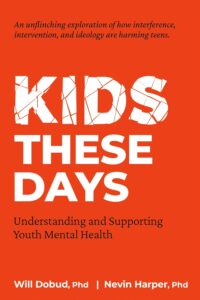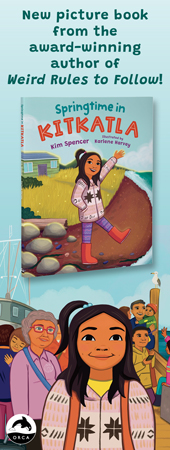Teenage blues
The generational gap between kids and their parents is an ongoing problem but it doesn’t have to be that way.
September 25th, 2025

Nevin Harper, eco-therapist and educator, has over 30 years’ experience in outdoor leadership and youth mental health.
“Each new generation brings fresh challenges the last one didn’t see, demanding new looks at new concerns. Cell phones, new drugs, social media and more bring complexities many of our parents didn’t experience. How many of us adopted the attitude toward our parents: ‘You’re just too old to understand.’”
Review by Graham Chandler
Growing up, how many times did we hear from a parent, “When I was your age, we…” and closing with “Kids these days!”?
In raising us, moms and dads often related to their own times growing up. Each new generation brings fresh challenges the last one didn’t see, demanding new looks at new concerns. Cell phones, new drugs, social media and more bring complexities many of our parents didn’t experience. How many of us adopted the attitude toward our parents: “You’re just too old to understand”?
The challenge intrigued two experienced therapists and researchers who studied the phenomenon and devised ways of dealing with it, understanding it, and offering others their respective findings in Kids These Days: Understanding and Supporting Youth Mental Health (New Society Publishers $24.99). The researchers reviewed hundreds of academic papers and talked to many experts to hear what they had to say about “kids these days.” They also interviewed many youths for their perspectives. Moreover, both researchers have extensive experience in related clinical work: Will Dobud is a social work clinician and researcher who works on innovative treatment programs integrating outdoor therapeutic experiences as well as being an advocate for youth impacted by the United States’ troubled-teen industry; Nevin Harper is a professor in the faculty of health at the University of Victoria and a registered clinical counsellor with over 30 years’ experience.
 “In the end, our goal was to understand why so many young people are hurting, starved for connection, and lacking the autonomy to adventurously explore adolescence,” they write. “Our task was to make sense of and share the research in an engaging way. We remain surprised by some of the evidence we found, and wonder why it is not more mainstream and in the public’s consciousness. There is solid evidence of harm, yet it is often left in the dark.”
“In the end, our goal was to understand why so many young people are hurting, starved for connection, and lacking the autonomy to adventurously explore adolescence,” they write. “Our task was to make sense of and share the research in an engaging way. We remain surprised by some of the evidence we found, and wonder why it is not more mainstream and in the public’s consciousness. There is solid evidence of harm, yet it is often left in the dark.”
Dobud and Harper distilled their results into three types of harm which need to be addressed in order to promote positive youth development today:
Interference – explores increased loneliness, loss of connection, digital interference and the influence of environmental toxins.
Intervention – takes a critical look at the labelling of mental disorders, psychotherapy, over-prescription of psychiatric medications, and universal school-based programs teaching social-emotional learning.
Ideology – examining how the dogma of safety has led to an “extinction of experience” and how this impacts youth.
Dobud and Harper’s first preliminary conclusion was: “We shouldn’t be blaming kids these days. We should be listening, learning, and leading.”
“The experts we talked to for this book were impressive because they deviated from the norm and worked to find new solutions,” say Dobud and Harper. “They don’t have all the answers, and by no means is our book definitive. In today’s world things change quickly…they leave us with more questions.”
But ignoring those questions clearly won’t help. “If we want to perpetuate the ‘kids these days effect,’ all we have to do is continue to rely on, and trust other adults to do the ‘adulting’ for us, while we bemoan today’s youth. Efforts to fix the teenager are likely to fail…we’ll continue to treat today’s youth as lazy, selfish, fragile, and anxious, as adults have done for millennia.”
“The experts we’ve relied on for this book often told us ‘don’t trust the experts.’ But through close listening and study, we’ve come to trust what they have imparted to us…the translation and dissemination of their work, however, by mainstream and social media, governmental regulatory bodies and corporate-speak and special interest groups is incongruent with much of their evidence and advice about healthy child and adolescent development.” What is eventually seen and heard by the public and presented as “expert” advice, often contradicts the experts Dobud and Harper used. Sources are listed; if you like, check them out.
The book is engagingly well-written and easy to follow—it should appeal to professionals and moms and dads alike. Numerous examples are provided to illustrate points, using that age-old mantra so many writers rely upon: “show, don’t tell.”
An example is the book’s description of a case where a 23-year-old young man, Danny, was forced to give up the apartment he shared with friends and move back into his mother’s home during the COVID pandemic. Danny used the opportunity to complete his bachelor of commerce degree online but that introduced new stresses like “the loss of his social life, peer relationships, and his routine of going to school, rugby practice, the gym, his girlfriend’s place, and the bar. Danny experienced life in a vacuum,” write Dobud and Harper. “Day by day he felt worse.” Finally, Danny sought therapy. His first counseling session was with Harper in a local park. Read the book to find out how Harper’s strategies were successful and how his unconventional approaches can work. The last session Danny and Harper had was just four months after they first met. When asked what he wanted to talk about that session, Danny said with a sense of pride, “I’d just like to hang out and let you know how good I’m doing.”
“Maybe what really needs to change is the adults these days,” the authors conclude. 9781774060223
Graham Chandler is a Vancouver-based freelance writer.


Thanks for the review Graham! be well, Nevin